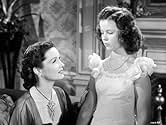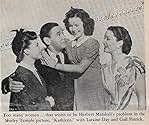Agrega una trama en tu idiomaKathleen is a 12 year old who lives in a big house with a nanny, a butler, maids, no mother and a father who is working most of the time. She dreams of a family with a mother, father and her... Leer todoKathleen is a 12 year old who lives in a big house with a nanny, a butler, maids, no mother and a father who is working most of the time. She dreams of a family with a mother, father and her, and tells everyone that she has such a family. Because of this story, she cannot invite ... Leer todoKathleen is a 12 year old who lives in a big house with a nanny, a butler, maids, no mother and a father who is working most of the time. She dreams of a family with a mother, father and her, and tells everyone that she has such a family. Because of this story, she cannot invite any friends over as they will see that it is not true. Kathleen and her nanny, Mrs. Farrel... Leer todo
- Dirección
- Guionistas
- Elenco
- Premios
- 2 premios ganados en total
- Miss Bewley
- (escenas eliminadas)
- Woman Customer at Shoner's Store
- (sin créditos)
- Dirección
- Guionistas
- Todo el elenco y el equipo
- Producción, taquilla y más en IMDbPro
Opiniones destacadas
Still MGM grabbed her for Kathleen where she's a girl entering puberty and quite frankly in this film a bit spoiled. She's a rich kid, daughter of Herbert Marshall who is all about business. She misses her late mom and Shirley also cannot stand the housekeeper/governess Nella Walker. And the one she really can't stand is Gail Patrick, the woman who Marshall wants to marry.
These films are usually so loaded in the sense we watch and can't believe that Marshall is such a blockhead that he can't see that Patrick is a bad woman and the lady psychologist that is there to treat Temple, Laraine Day is the woman for both of them.
Kathleen is not in a league with some of Shirley's best work at 20th Century Fox, but it is reasonably entertaining.
All child actors must eventually face uncertainty when they outgrow the young roles that made them successful. Shirley Temple was beyond successful as a child actress, capturing the hearts of moviegoers for years. When she became too old for the "Good Ship Lollipop", would she be able to transition successfully into teen roles and adult roles?
In 'Kathleen", Shirley is 13 years old. The drama of this film is similar to dramatic scenes she had previously played as a child, but viewers expect more from older performers. In "Kathleen" she portrays angst and outrage, but her performance is too childlike, which impacts the early scenes especially. In a few years, she would be better equipped to emote with greater depth. In 1947's "That Hagen Girl", for example, she adeptly portrays a troubled teen beset with a haunting past who is the target of an entire town. 1949's "A Kiss for Corliss" (A comedy with David Niven) is effectively the end of her film career, so she used her newfound skills only sparingly.
Watch for Laraine Day and Gail Patrick, who face off over Kathleen's well-being and the girl's father, played by Herbert Marshall. All of them acquit themselves well. Day, remarkably, is only 8 years old than Shirley, but convincingly plays a professional woman who possesses authority and confidence.
One final note: this film was released soon after the attack on Pearl Harbor. I can only wonder what effect that had on attendance and the public's willingness to be entertained. The nation was in shock and dealing with important matters that completely altered its way of life. A determined response to aggression, and fears about worldwide aggression, were paramount. Still, the nation would learn to use cinema to channel its patriotic fervor and, conversely, to escape harsh realities.
"Kathleen" is an odd film. It isn't bad, but along with other films like "The Blue Bird", it managed to alienate the public from Temple because the films were such a departure from the sweet Temple films of the 1930s. Part of this, of course, is because Shirley was older and the old style films wouldn't have worked as well with a child about to become a teen. Part of it, however, is that the studios didn't really seem to know what to do with her.
I liked the Kathleen character. Her manipulative personality was pretty funny and I liked some of her bratty moments. However, what I didn't like about her were the fantasy scenes. These involved musical interludes that just weren't necessary and really slowed down the film. In fact, had they cut them all out, the movie would have worked much better--especially since music seemed inappropriate to this style of film. Plus, while Shirley was great singing as a child, here she seems a bit out of her element in these production numbers.
So is it worth seeing? Sure. The negatives about this one are far outweighed by the good. Shirley's performance is very nice and the story quite clever. And, although the ending was a bit sticky, I did like it. A very different sort of film for the actress, that's for sure--but a nice one. But also it's so different that I could easily see folks disliking it.
In Shirley Temple's autobiography "Child Star", there's a photo of her on the set of "Kathleen" with bongos strapped to her waist. She's in a shell-shaped bandstand with other cast members performing a calypso number.
She writes that the stage undulated (moved in a wave fashion), making it very difficult for the dancers to get the scene down right. Everybody had to stay late for constant re-shoots.
So, in the movie from YouTube, the scene is not in there. There's just one song and dance routine but it's not a calypso with the bongos. The one from YouTube ran almost an hour and a half.
¿Sabías que…?
- TriviaA body double for Herbert Marshall was used in the scene where his character runs past Shirley Temple and up the stairs after Mrs. Farrell opens the box containing a firecracker. Marshall lost a leg in WWI and body doubles were always used whenever his character had to run or walk quickly up staircases.
- Citas
Mrs. Farrell: If you were a nice girl with a nice clean mind, you wouldn't keep a diary.
Kathleen Davis: You peeping Tom!
- ConexionesReferenced in We Must Have Music (1941)
- Bandas sonorasAround the Corner
(1941)
Music and lyrics by Roger Edens and Earl K. Brent (as Earl Brent)
Played during the opening and closing credits
Played on a music box several times
Sung by Shirley Temple (uncredited) and chorus in a musical review during her daydream
Played as background music often
Selecciones populares
Detalles
- Tiempo de ejecución1 hora 28 minutos
- Color
- Relación de aspecto
- 1.37 : 1
Contribuir a esta página




























